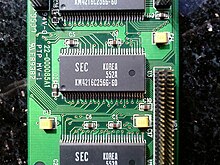
Back Video RAM (VRAM) Azerbaijani Video RAM BS VRAM Catalan Video RAM Czech Video Random Access Memory German Memoria gráfica de acceso aleatorio Spanish Video RAM Finnish VRAM Galician VRAM Croatian Video RAM ID
This article has multiple issues. Please help improve it or discuss these issues on the talk page. (Learn how and when to remove these template messages)
|
Dual-ported video RAM (VRAM) is a dual-ported variant of dynamic RAM (DRAM), which was once commonly used to store the framebuffer in graphics adapters.
Dual-ported RAM allows the CPU to read and write data to memory as if it were a conventional DRAM chip, while adding a second port that reads out data in a serial fashion. This makes it easy to interface with a video display controller (VDC), which sends a timing signal to the memory and receives data in the correct sequence as it draws the screen. Because the CPU and VDC access the memory simultaneously on different ports, dual-ported RAM does not require the CPU to pause while the VDC uses memory, thereby eliminating the associated wait states and improving overall system performance.
Dual-ported RAM was common from the mid-1980s into the mid-1990s. After that date, new forms of high-performance memory began to be used that eventually replaced dual-ported designs. As these other forms of memory are also known as video memory, and thus VRAM, it sometimes confused with this older form of memory.
